Bellingham to Sedro-Woolley: A Transit Trek Venturing Over the Chuckanuts to Skagit County
Transit Diary: Despite my doubts, a very tight bus connection in Burlington worked. Barely.

Traveling through the Chuckanut Mountains on Monday morning on a Route 80X County Connector bus headed to Skagit County from Bellingham, I was convinced that summoning a Lyft would be necessary to reach my destination in Sedro-Woolley. Attempting an all-transit trek to meet up with work colleagues from Seattle for an event our team helped organize would be admirable, but I was prepared for it to fall apart due to the realities of bus schedules. I even had a co-worker on standby ready to drive to the Chuckanut Park & Ride in Burlington just in case my bus connection or Lyft came up short.
As someone who lives car-free in (and works remotely from) Bellingham, most of my work travel involves heading into Seattle a couple times a month. As it happened, my co-workers were headed in my direction. But Sedro-Woolley, a farming community of about 12,000 people along the North Cascades Highway, is a "closeby yet so far" destination if you depend on transit.
When I initially used Google Maps to plot out whether it would be possible to make the morning event on time, I was disappointed but not surprised. If I drove, the 25-mile trek would take about 35 minutes from Bellingham's Southside. But the best transit option would take at least 2 hours and 30 minutes. Other transit routing options were headed north of 3 hours.
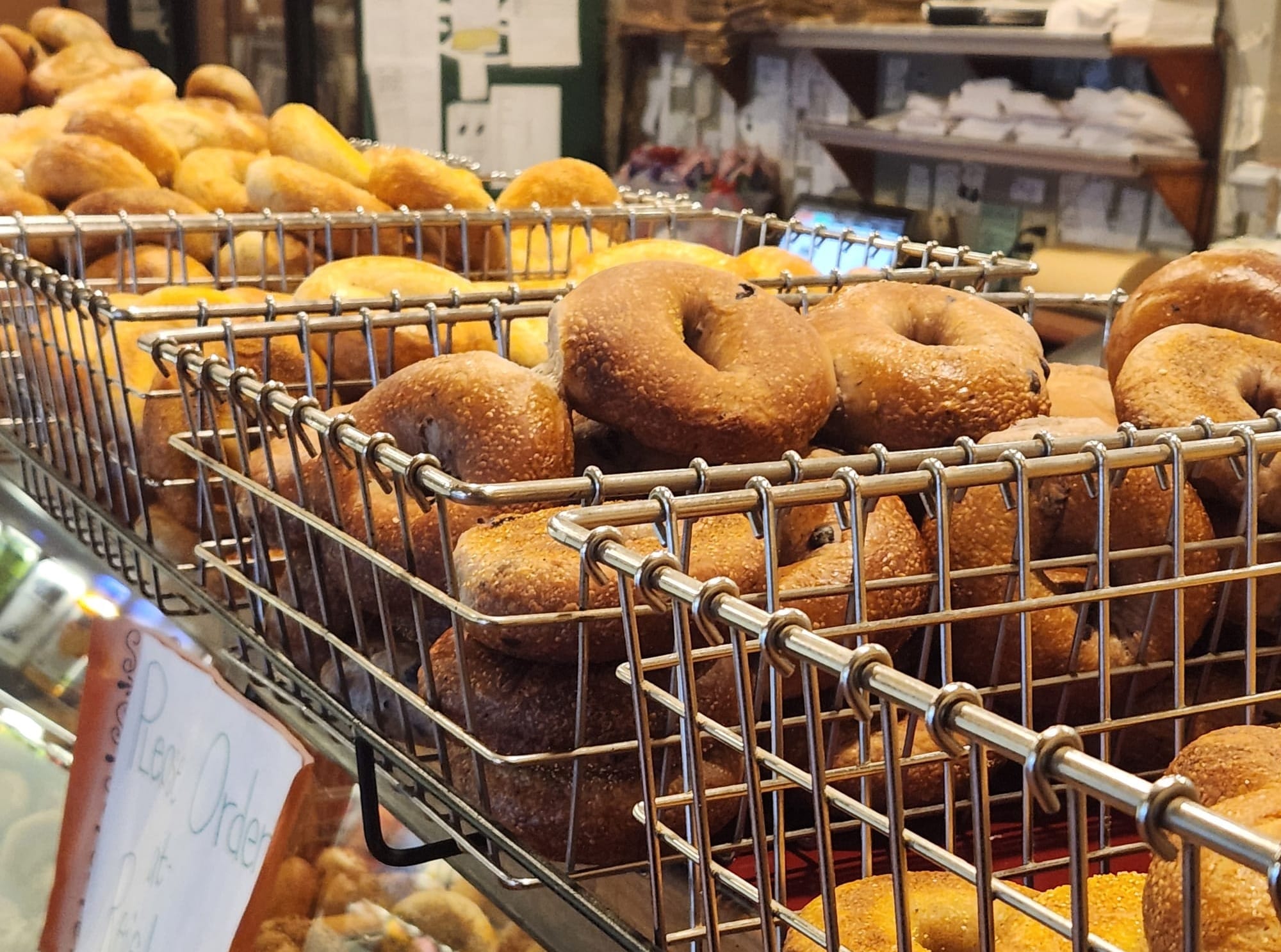
But door-to-door, my transit trip took less than 2 hours. That included an abbreviated breakfast break at The Bagelry (1319 Railroad Avenue), which is a short stroll or roll from the Whatcom Transit Authority's Bellingham Station. It's a perfect place to grab a quick bite between buses. (I recommend the garlic-feta-dill cream cheese spread.) I had 20 minutes between the time my Route 1 bus arrived downtown and the start of the second leg of my trek to Skagit County via Route 80X, a County Connector bus route co-operated by the WTA and Skagit Transit and part of a larger network of routes connecting key transit nodes in Snohomish, Skagit, and Whatcom counties.
For Bellinghamsters considering a trek south on Route 80X to Skagit County weekday mornings, there are departures from Bellingham Station at 6:40 a.m., 7:40 a.m., and 9:40 a.m. (There are six additional trips on weekdays, the last leaving Bellingham for Skagit County at 6:15 p.m., and fewer trips on Saturdays and Sundays.)
Riding through the Chuckanut Mountains is fun, even when the skies are overcast. There are large windows to enjoy the scenery, including Lake Samish and the steep forested ridges of the surrounding mountains and foothills. Skagit Transit's seats are quite comfy and the bus for my trek south wasn't crowded, so the ride was quite pleasant.
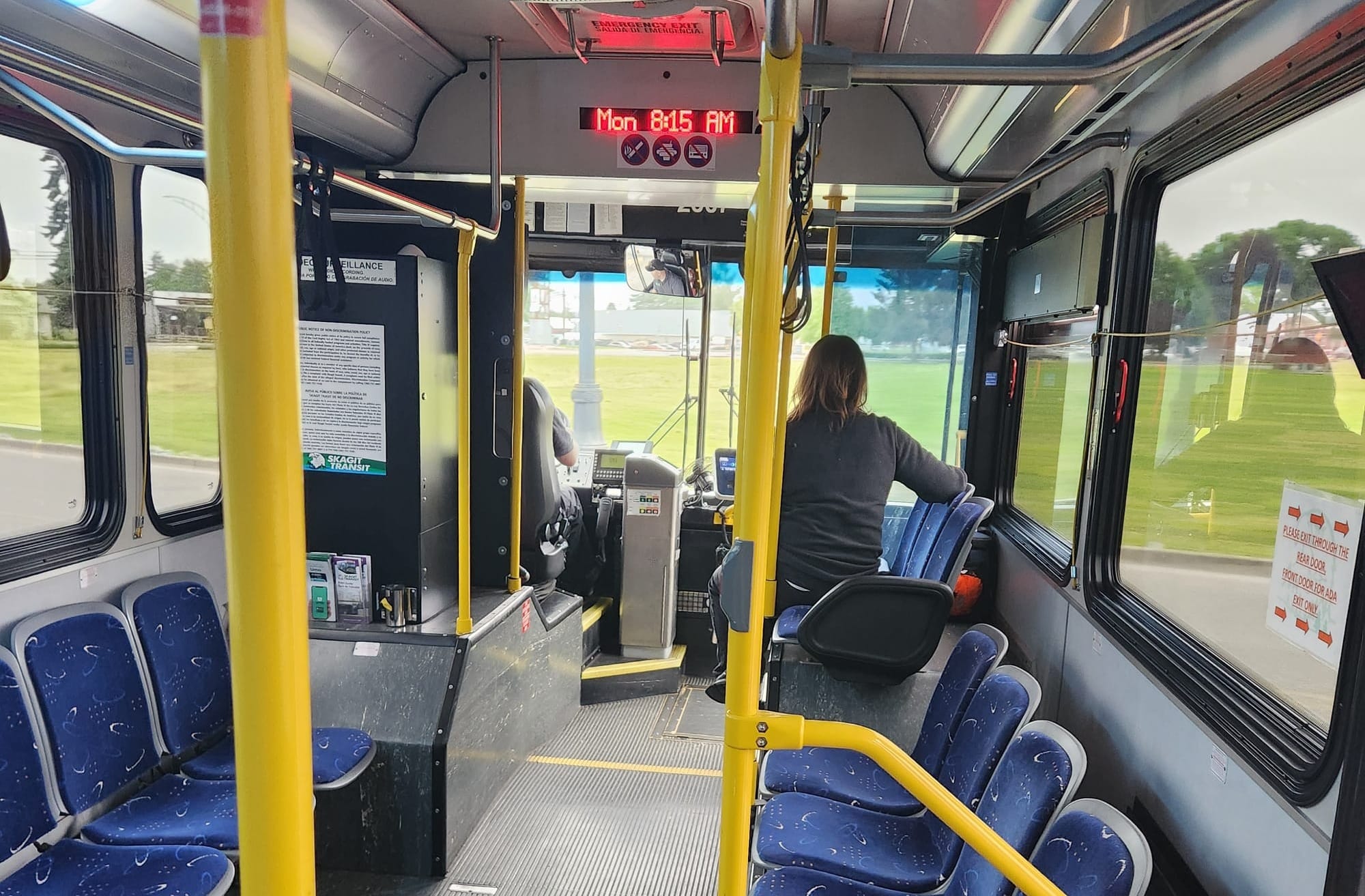
A Very Tight Connection to Route 301
But I did nearly miss my bus connection to Sedro-Woolley at the Chuckanut Park & Ride, where I planned to transfer to Skagit Transit's Route 301 (Sedro-Woolley Park & Ride to Chuckanut Park & Ride via United General Hospital). This is why I was somewhat nervous about this trip and had a back-up plan. Before continuing south to Skagit Station in Mount Vernon, Route 80X from Bellingham arrives in Burlington at 8:15 a.m., which is when Route 301 and other Skagit Transit buses depart. Seeing the Route 301 bus departing the transit center right after I stepped off the Route 80X bus, I ran across the platform and flagged down the bus operator, who stopped and let me on.
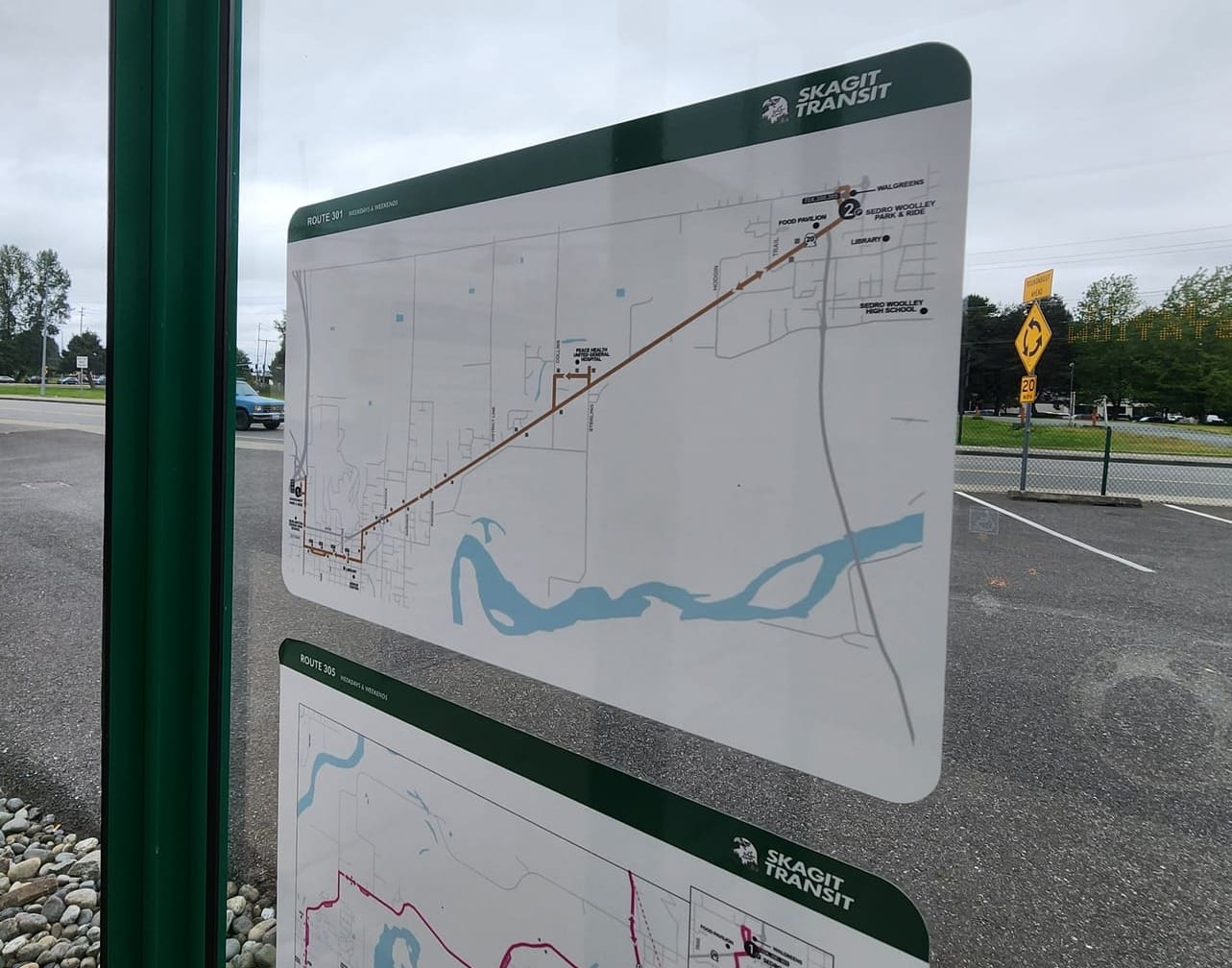
Route 301 runs hourly from the Chuckanut Park & Ride leaving 15 minutes after the hour until 8:15 p.m. Traveling through Burlington's commercial corridor along Fairhaven Avenue, buses on this route navigate numerous all-way stops and railroad crossings. Route 301 then cuts north to State Route 20 (North Cascades Highway), then east toward Sedro-Woolley, about 6 miles away. But part way there, Route 301 buses travel through the campus of United General Hospital, where the route loops through low-speed parking lots, hits a few speed bumps, and backtracks before continuing on to Sedro-Woolley on S.R. 20. Serving a medical center with transit is obviously important, but it does create a slow side journey if your destination is Sedro-Woolley.
Route 301 terminates at the Sedro-Woolley Park & Ride on the west end of town near a junction where S.R. 9 meets S.R. 20, which led me to my next decision.
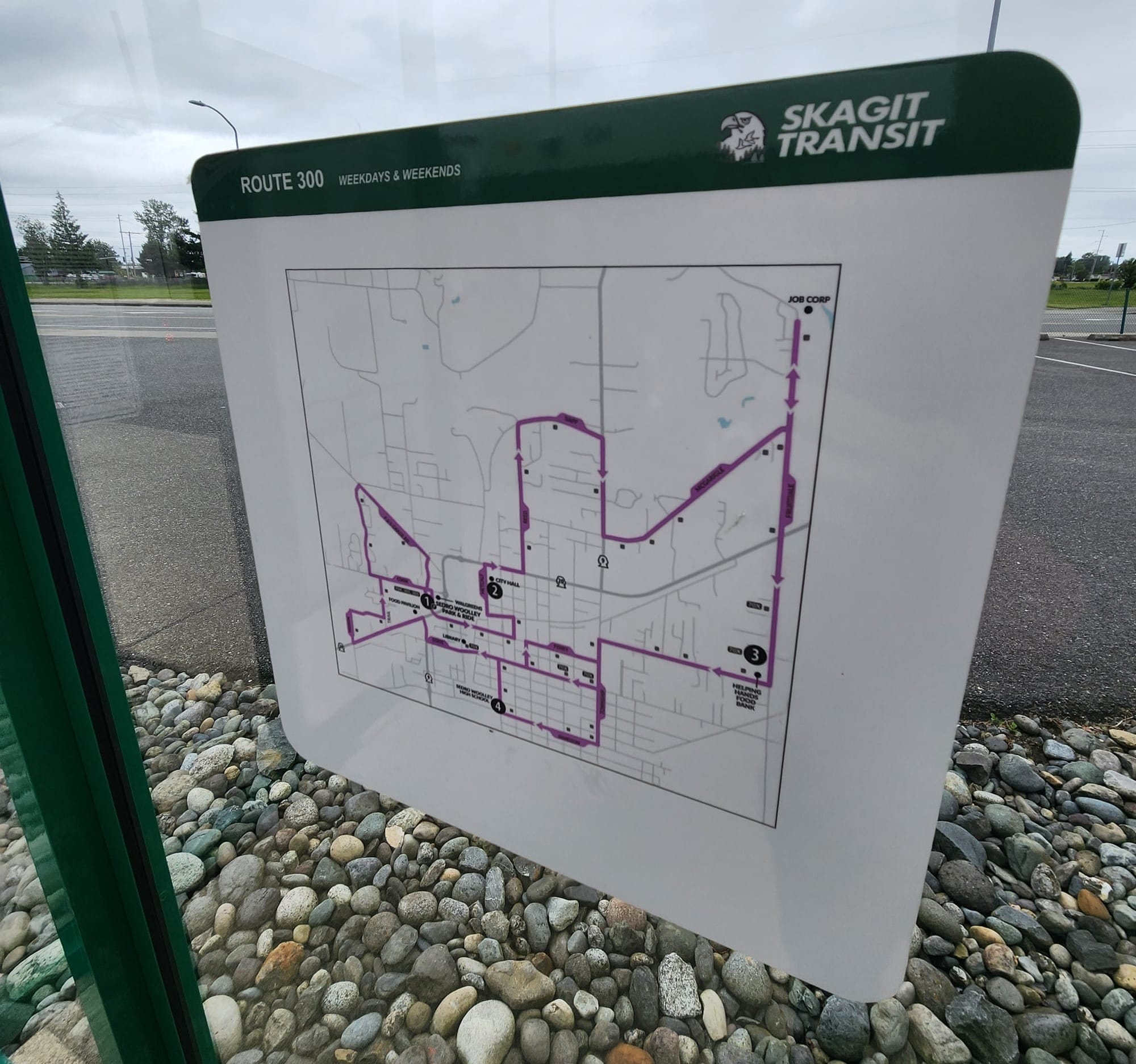
Walk Into Town or Take Another Bus?
The Sedro-Woolley Park & Ride, however, isn't in the center of Sedro-Woolley, nor was it near my destination, the Sedro-Woolley Community Center (703 Pacific Street) at Memorial Park, east of the city's commercial center. It was walkable from the park and ride, but it was mist-drizzling and the walk across the state highways and adjacent railroad tracks didn't seem appealing.

But Skagit Transit's Route 300, which travels on a milk-run looping route through and around Sedro-Woolley, was at the bus hub and would be departing in about 10 minutes. I asked a Skagit Transit bus operator how close Route 300 would get to the community center. "I go right there, but it'll take awhile," given the route's journey through Sedro-Woolley. By walking, "you'll probably beat me by 15 minutes." I decided to take it a few stops into Sedro-Woolley's downtown area and walk the rest of the way. It was only a few blocks, very flat, and had sidewalks along most of the streets. I made it with plenty of time to spare.
Making the Return Trip to Bellingham Via Tacos Tecalitlan
For the return trip to Bellingham using transit, there was a conveniently timed Route 70X (Mount Vernon to Concrete via Sedro-Woolley) at 11:30 a.m. headed west through Sedro-Woolley toward the park and ride. While I could of taken Route 70X all the way to Skagit Station in Mount Vernon (it bypasses the Chuckanut Park & Ride) to connect with Route 80X to Bellingham, I decided to go back the way I came, via Route 301, back to through Burlington so I could make a return visit to Tacos Tecalitlan for lunch. Just like last week on my way south to Everett, I had a generous amount of time before my next bus departure, so I naturally wandered back across Burlington Boulevard for tacos.

Unlike last time, I didn't neglect to order the chicharron tacos, as recommended by Tan Vinh of The Seattle Times. They were very delicious and Tacos Tecalitlan was packed for lunch. I had plenty of time to enjoy the tacos and make my way back across the street before the Route 80X bus arrived.
Lessons From the County Connector Buses
To be fair, I've only been on the County Connector bus routes a couple times now so I don't know their passenger rhythms well enough to comment more definitively about their service. But from what I've experienced, I've found them to be timely, speedy, and while not full, not empty either.
People obviously use these buses and rely on them to reach appointments, health care services, and shopping. These types of long-haul express routes are typically expensive for transit agencies to provide, but they also provide vital connections for those who aren't able to drive or don't want to drive.
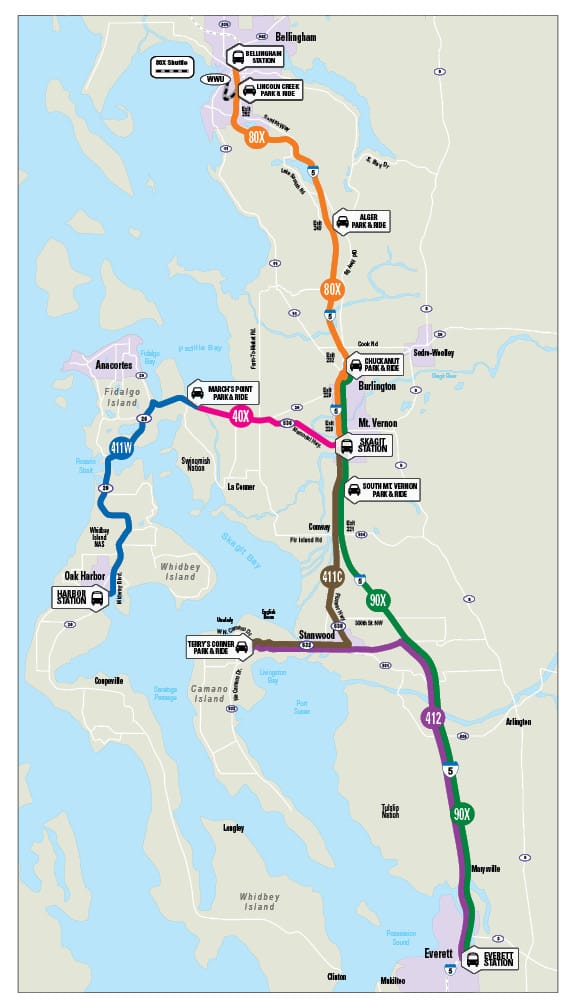
When we think about the spillover effects of high housing costs in Bellingham and Whatcom County, Route 80X is an important connection for people to reach jobs and opportunities north of the Chuckanuts from the south, including Western Washington University students who live in Skagit County and commute into Bellingham.
These buses are also important for regional connectivity and provide a backup transit pathway between Bellingham and Seattle (via Mount Vernon and Everett) when Amtrak Cascades buses and trains are sold out or experiencing a service disruption. When factoring in the transfer time, these buses are slower but are less crowded than Amtrak Cascades buses and trains.
While the County Connector themselves provide quick service along I-5 — Route 80X from Bellingham to Burlington is scheduled for 35 minutes, which is competitive with driving — where the overall travel time adds up is where bus schedules for connecting routes don't line up and you're left waiting around a transfer point. That might be 20 minutes or it could be an hour or more. When a timed connection works, it can be magic. But overall, you have to be hyper aware of the bus schedule and connection points to make it all work. And that's where the transit skeptic would likely point out: That sounds complicated and inconvenient. Why don't you just drive instead?
Of course, not everyone can drive or wants to drive. So our region is lucky to have these County Connector bus services. While these routes might not take you directly to your destination, (unless that destination is Tacos Tecalitlan), they constitute a vital transit service that stitches our region together.
- Have local and regional transit and transportation news to share? Email BhamByBus.
- Follow BhamByBus on Instagram.
